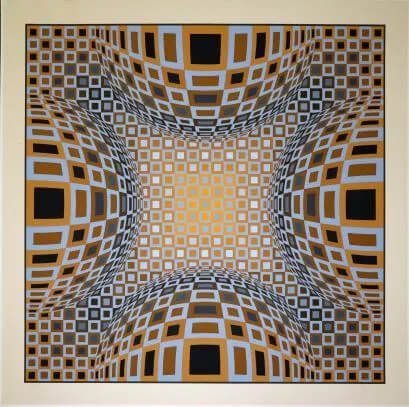Is the purpose of art to look pretty or to help the viewer see the world from a different perspective? Or, is art a purely subjective medium that is designed to mean different things to different people? The umbrella of art is so vast, that it’s hard to create an official definition, and yet everyone seems to have an idea of what makes something “art.”
So, it’s easy to look at the works of an artist like Victor Vasarely and recognize that the lines that separate art from everything else are blurry at best. For example, is a chessboard a work of art? What if you were to bend and pull the features of the board so that it took on a more three-dimensional quality? At what point does it go from being a “pattern” to “art”? These are the lines in which Vasarely thrived, and his legacy of Op Art is still as vital today as it was when the artist was still alive.
Op Art is short for Optical Art, an abstract art form that uses optical illusion as a primary element. Characterized by the bending or warping of lines, adding ondulation, and altered perspective techniques. Early artists that experimented with these techniques were Victor Vasarely, M. C. Escher, and Josef Albers. As the form progressed additional Op Art artists entered the scene, including Bridget Riley, Jesus Rafael Soto, and Richard Anuszkiewicz, among others. Victor Vasarely is considered the founder of the Op Art style.
Biography
Early Life and Education
Victor Vasarely was born in Pécs, Hungary, in 1906. At a young age, his family moved to Pieštany in Slovakia, which is where he spent his childhood. There’s not much information about Vasarely from this period, but the scant details we do know paint a picture of a young boy who was fascinated by science more than art. That’s partially why he chose to pursue a medical degree at Eötvös Loránd University in Budapest when his family moved there in 1925.
However, after two years at medical school, Vasarely decided he would rather pursue a career as an artist and dropped out of the university. He began taking painting classes and, in 1929, enrolled in the private academy of Sándor Bortnyik. Bortnyik was a well-respected avant-garde artist of the period whose major influences were the German Bauhaus. Bauhaus pieces focused on geometrical abstraction and applied art rather than fine art aesthetics.
During his time at Bortnyik’s academy, Vasarely met and married a fellow artist named Claire Spinner. Their original plan was to move to Germany to study and practice art together, but given the rise of Nazism at the time, they chose to move to Paris instead in 1930.
In Paris, Vasarely became a commercial artist, using the foundations he learned in Budapest to become a graphic designer. He designed logos, created ads and posters, and used his applied art training to practice his techniques and support his growing family. Vasarely’s first child, Andre, was born in 1931, followed by a second child, Jean-Pierre, in 1934.
Because Vasarely’s graphic design career was successful, he was able to pursue other creative endeavors in his spare time. He was able to blend his love of science and art, using experimentation and rigid principles to uncover the artistic aesthetic hidden within geometric shapes and chromatic patterns. This quote may help shed light on his mindset as he developed his artistic endeavors:
“A painter is no more an inspired, empirical individual, but an educated researcher, resembling a scientist. He is aware of both physical and psychological needs, as well as the rights of humanity.“
One piece from this early period, Zebra, illustrates how Vasarely merged geometry with the natural world. The image is of two zebras intertwined, the black and white patterns on their bodies creating intricate shapes that offer a slight 3D effect. In fact, Vasarely loved to add depth to his work through lines and geometry rather than a vanishing point perspective. It was this love of optical illusions that helped Vasarely start the Op Art movement.
Death
Although the Op Art heyday ended in the 1970s, Vasarely continued to create paintings, sculptures, and other artistic works throughout his life. In 1987, the city of Budapest opened the Vasarely Museum, starting with a massive donation of work by the artist himself. The museum still exists today and celebrates the life and work of Vasarely, who died in Paris 10 years later in 1997. He was 90 years old, leaving behind two children and a legacy of art that is still revered today.
Op Art Movement
After World War II, Vasarely moved back to Paris and took over a studio to pursue his artistic endeavors full-time. It was during this post-war period when he really came to realize that form and color were intrinsically linked, thanks in part to his holidays in the south of France, where harsh sunlight would offer sharp contrasts between the colors and forms of the natural world and their stark black shadows.
The Op Art (short for Optical Art) movement officially began in 1955 when Vasarely and other contemporaries held a group show at the Galerie Denise René in Paris. This show was the first time that optical art was truly on display, although many art historians consider works like Zebras to be the precursor to this movement.
Optical Art became more and more popular in the late 50s and throughout the 60s, influencing other artists of the era as well as advertising and graphic design. Vasarely and other Op artists grew their fame and their skills during this period, hosting shows around the world. Vasarely not only experimented with geometric shapes and colors on canvases but also branched out into sculpture. He even worked on architectural projects, including the French pavilion at the 1967 World Expo in Montreal.
The Legacy of Victor Vasarely
Although Vasarely’s merging of geometry and art can trace its roots back to the constructivist movement of the early 1900s, his work is wholly unique and fascinating to behold. Everything he touched, from canvases to plastic sculptures, is imbued with his DNA. He was always striving to blend art and science to create something both magical and practical.
It’s hard to determine the influence of Victor Vasarely, but any artist who has dabbled in geometric or optical art owes a small debt of gratitude to him. He helped bring this style to the masses, and everyone from art students to historians to art lovers can appreciate his studies of form and color. His art was accessible to everyone, thanks in part to his strong belief that art was intrinsically fundamental to the health of humanity itself.
This quote of his also helps sum up his legacy, “a contemporary painter can no longer be content with painting pretty little pictures. He must beautify the details of the modern, grandiose environment, since people need plastic forms same as they need sunlight, oxygen, or vitamins.“
Famous Works of Victor Vasarely
Vasarely was a prolific artist, so it’s not hard to come across one of his pieces. Plus, since they are so accessible, they can work in any location, be it an office foyer or at home above the fireplace. Here are some of his famous works you can purchase.
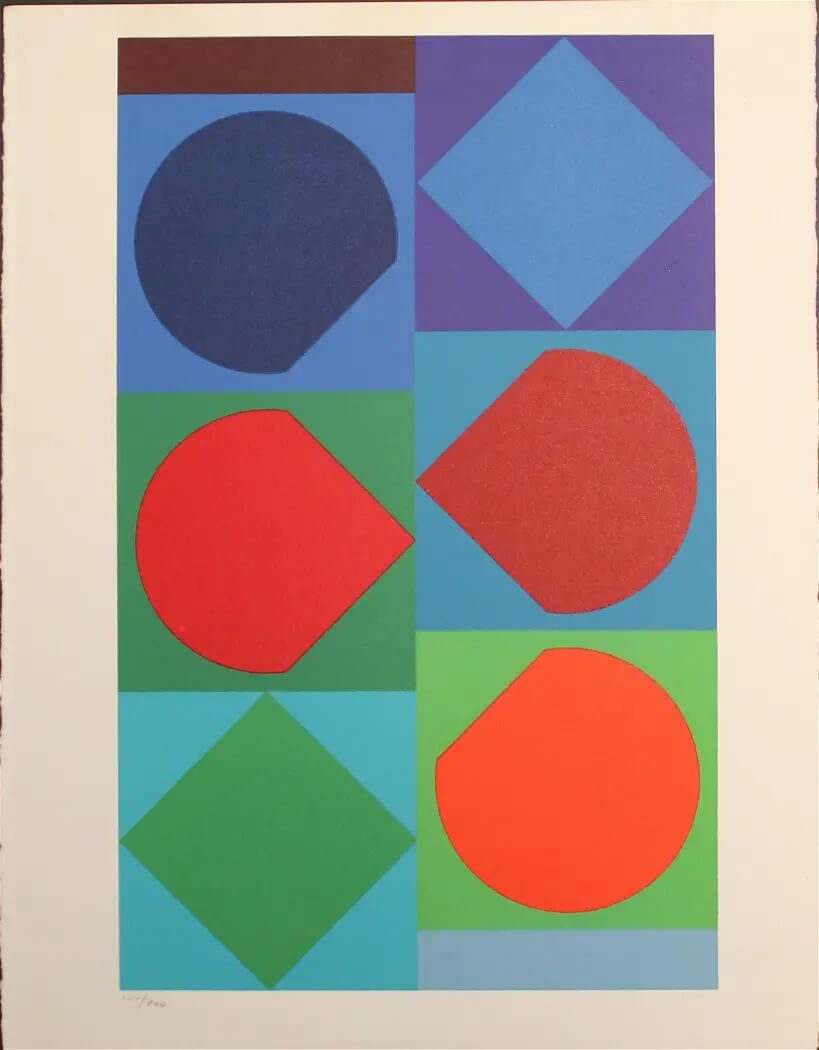
This painting is a perfect encapsulation of Vasarely’s fascination with form and color. The piece showcases multiple geometric shapes, including circles, triangles, diamonds, and squares. Some of the shapes are a mixture, with one side being circular and the other forming the point of a triangle. The colors of the shapes and the background are different, so they clash and capture the attention of the viewer.
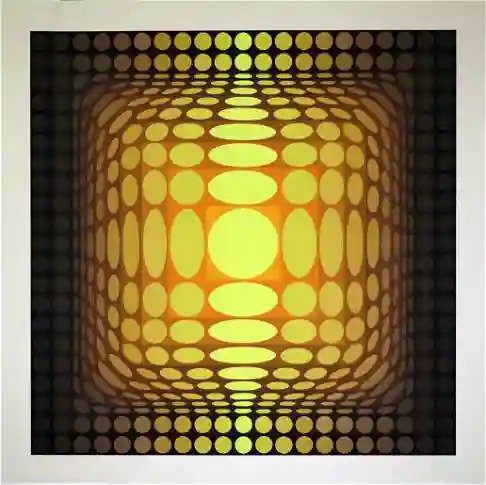
This painting explored the visual effects of optical illusions and geometric patterns. This piece is a prime example of Vasarely’s unique style, characterized by intricate geometric shapes and bold colors. The painting is a mesmerizing display of optical illusion, with a series of concentric circles and squares that appear to be in motion.
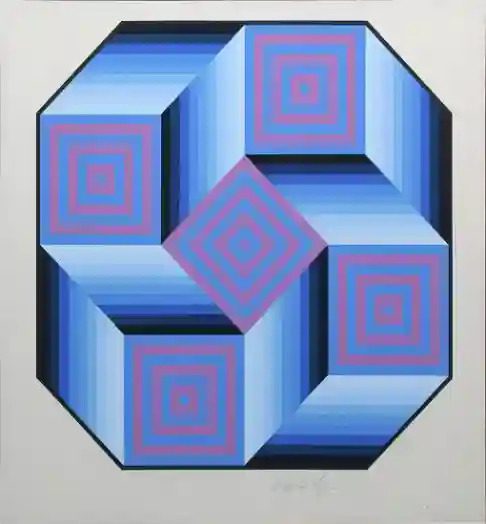
Here is another abstract painting by Vasarely. The painting is made up of a series of black-and-white geometric shapes that are arranged in a grid-like pattern. All the different sizes of shapes are arranged in a way that creates a sense of movement and dynamism. So, this artwork comes with a signature and a number to verify its authenticity.
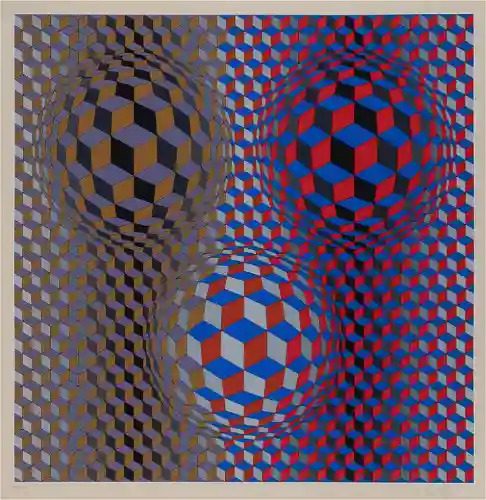
Nebulus II is a painting that features a series of interlocking black and white squares arranged in a grid pattern. The squares appear to shift and vibrate as the viewer’s gaze moves across the painting, creating a sense of movement and depth. The effect is both mesmerizing and unsettling, inviting the viewer to contemplate the nature of perception and reality.
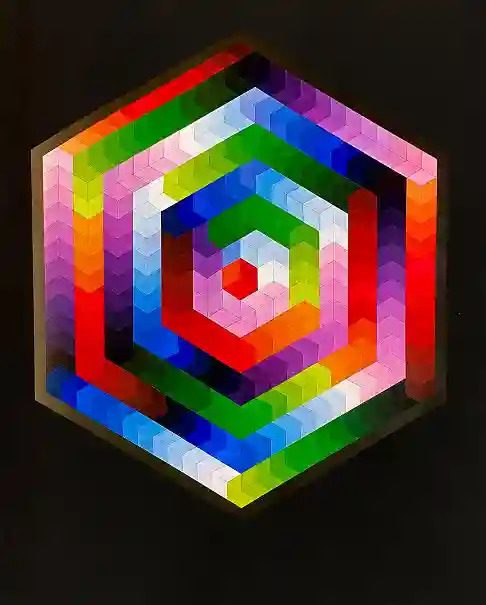
The Hat III consists of a series of repeating diamond shapes in shades of blue, green and other colors which are arranged in a grid-like pattern. The edges of each diamond are crisp and precise, creating a sense of sharpness and precision that is characteristic of Vasarely’s work.

This painting features a series of interlocking squares, arranged in a precise grid pattern. The squares are rendered in shades of blue, ranging from pale pastels to deep, rich blues, creating a sense of depth and dimensionality. The squares are also carefully aligned to create the impression that they are shifting and tilting, giving the painting a dynamic, almost kinetic quality.
If you are looking for any artwork by Victor Vasarely, call us now at 267-687-8378 or leave an inquiry on Dane Fine Art. We are happy to help you find the artwork you are looking for. Explore more art and artists with Dane Fine Art.

